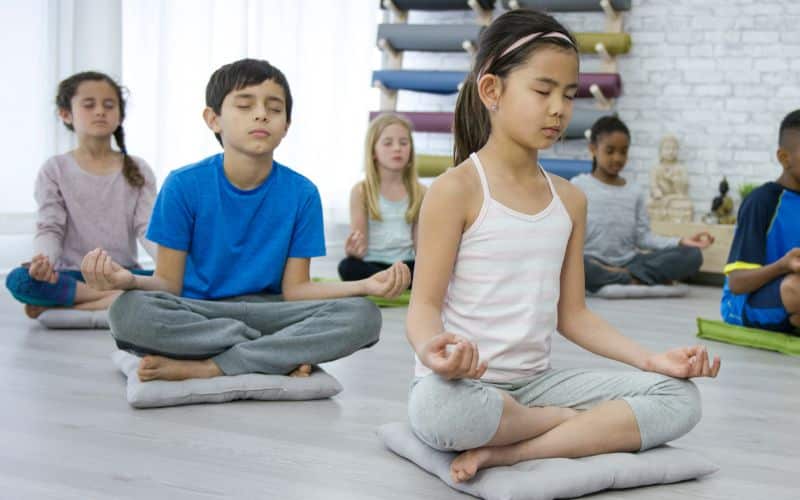Calmness, compassion and curiosity, oh my! Mindfulness meditations for kids are age-appropriate exercises that help kids explore and enjoy their moment-to-moment experience. Kids’ practices are short, fun and engaging.
Meditation for children has become a beloved, integral part of many school programs around the world. Children can reap all the benefits of meditation that adults enjoy. Introducing mindfulness to kids at a young age plants seeds for their lifelong mental, emotional and social well-being.
In this article, we’ll introduce you to the world of meditation for children.
Benefits of Kids Meditation
When kids practice meditation, they grow their mental, emotional and social intelligence.
Mental benefits:
Emotional benefits:
Social benefits:

Best Age for Kids to Start Meditation
Children of just about any age can meditate. Kids as young as three or four can enjoy and benefit from simple exercises. Look for guided meditations adapted for particular age groups and kids’ attention spans!
There are a few guidelines to keep in mind to find practices that are a good fit for your child. The maturity of each individual child will guide your choices.
Types of Meditations Suitable for Kids
There are as many types of children’s meditation as there are adult practices. These meditations fall into two categories:
Mindfulness Meditations for Kids
Mindfulness meditations for kids are traditional practices that are modified for children. Kids are guided through explorations of sensation and perception to ground them in the present. Older children learn how to watch their thoughts and feelings with some objectivity and self-care.
These meditations include practices like:
Imagination Meditations for Kids
Kids love meditations that harness the power of their imagination. These meditations guide kids through a full-body, positive experience, like:
A Guided Meditation Practice for Kids
Here is an example of a mindfulness meditation for kids that uses attention to sound.
Guided Audio Meditations for Kids
Children love storytelling, don’t they? And most kids enjoy being read to when they’re cosy in bed ready for sleep.
So, guided audio meditations, written just for kids, are a great way to introduce mindfulness. You can choose meditations designed especially for a child who gets anxious falling asleep. Or, you can pick an imaginative journey that incorporates mindfulness concepts into a fun, calming story.
Tips to Help Kids Meditate
How can you introduce children to meditation at home or at school? Start with a brief, fun chat about meditation. Here are a few tips:
When you’re ready to guide children through an exercise, remember these tips:
Mindfulness Comes in All Shapes and Sizes!
In addition to these tips, keep in mind that any activity can be done mindfully. You can add a mindful element to something kids do every day, like eating. Or, you can choose from the many wonderful mindfulness activities created just for kids.
Integrating mindfulness principles into everyday life and everyday challenges is just as important for kids as for adults. Playful, mindful activities for children:
You can choose a “mindful moment” to do together every day for a while. You can mindfully brush your teeth and talk about what it was like. Or, you can be mindful as you walk to the corner store and discuss new things you noticed.
You can help your child see mindfulness as a simple, fun thing they can add to whatever they’re doing. And doing it with you will become another great thing you share.
Also check out our Meditation Worksheets for Kids collection for an effective and fun practice.
Meditation for Kids FAQs
How Can Kids Be Mindful?
Kids can be mindful by “being here, without judgment,” just like adults. Practices tailored for kids help them to explore their inner and outer experiences with curiosity and kindness.
Can I Teach My Children Meditation?
Yes, you can teach your own children meditation. We hope our expert tips in this article can help you get started with some confidence. And you’re welcome to explore our kids’ resources here on MindfulnessExercises.com
My Kid Won’t Sit Still! What Should I do?
If your child won’t sit still for meditation practices, that’s ok. There are meditations that practice awareness through movement, like pretending to be a tree moving in the wind.
Can Meditation Help Kids With ADHD?
Recent studies show that meditation can be an empowering practice for kids with ADHD. Meditation shows them concrete ways to slow down, calm their nervous system and focus their attention.
Can Meditation Help Kids With Anxiety?
Meditation is a proven tool kids can use any time and anywhere to help with the physical, mental and emotional effects of anxiety.
Is Meditation Popular in Schools?
Meditation for kids has become a common feature in many classrooms. Teachers use meditation to strengthen attention, performance and cooperation with others. Some schools even use meditation for kids’ time-outs.
Conclusion
Teaching children how to meditate is a gift that can serve them all the way into adulthood. The basic skills of self-awareness and self-compassion create a caring, safe space for kids to learn about themselves and their world.
Medical Disclaimer
The information contained in this article is not a substitute for any professional advice or treatment, including the advice and treatment of a licensed health care or mental health professional.



















